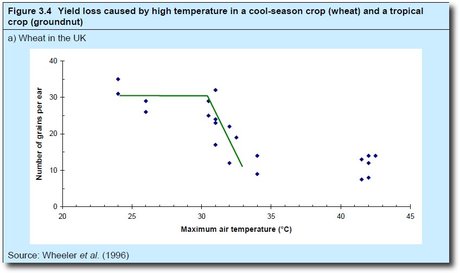For reasons that I can't quite recall, I found myself looking at Chapter 3 of the Stern report, where I noticed a graph on yield losses in wheat.
The text discussing the figure has this to say:
High temperature episodes can reduce yields by up to half if they coincide with a critical phase in the crop cycle like flowering (Figure 3.4).
The change in behaviour at 30°C seems quite distinct, but it's always good to look at the paper behind the headline. From the minute you read the title, you get a sense that all is not quite well with Lord Stern's work.
Growth and yield of winter wheat (Triticum aestivum) crops in response to CO2 and temperature.
So it's a study on winter wheat. I don't know about you, but I haven't come across any suggestions that winter and spring temperatures in the UK might exceed 30°C, but perhaps I'm wrong.
The abstract is interesting too:
Crops of winter wheat (Triticum aestivum L. cv. Hereward) were grown within temperature gradient tunnels at a range of temperatures at either c. 350 or 700 μmol mol−1 CO2 in 1991/92 and 1992/93 at Reading, UK. At terminal spikelet stage, leaf area was 45% greater at elevated CO2 in the first year due to more tillers, and was 30% greater in the second year due to larger leaf areas on the primary tillers. At harvest maturity, total crop biomass was negatively related to mean seasonal temperature within each year and CO2 treatment, due principally to shorter crop durations at the warmer temperatures. Biomass was 6–31% greater at elevated compared with normal CO2 and was also affected by a positive interaction between temperature and CO2 in the first year only. Seed yield per unit area was greater at cooler temperatures and at elevated CO2 concentrations. A 7–44% greater seed dry weight at elevated CO2 in the first year was due to more ears per unit area and heavier grains. In the following year, mean seed dry weight was increased by > 72% at elevated CO2, because grain numbers per ear did not decline with an increase in temperature at elevated CO2. Grain numbers were reduced by temperatures > 31 °C immediately before anthesis at normal atmospheric CO2 in 1992/93, and at both CO2 concentrations in 1991/92. To quantify the impact of future climates of elevated CO2 concentrations and warmer temperatures on wheat yields, consideration of both interactions between CO2 and mean seasonal temperature, and possible effects of instantaneous temperatures on yield components at different CO2 concentrations are required. Nevertheless, the results obtained suggest that the benefits to winter wheat grain yield from CO2 doubling are offset by an increase in mean seasonal temperature of only 1·0 °C to 1·8 °C in the UK.
The abstract is somewhat unclear, but we seem to have a beneficial effect from CO2 fertilisation offset by temperature increases. The tentative conclusion seems to be that these broadly cancel but that more work is required to prove the point.
Stern seems to have picked up on a fall in seed head numbers. I can't see anything in the abtract to support his claim that that there is a fall in yield, but this may be in the body of the paper. It's not clear from the abstract what the counterbalancing effect of CO2 was on these seed heads.
It seems to me that it must be a perilously difficult problem to predict the effect of temperature changes on crops. The threshold demonstrated in this paper seems clear enough, but do we have the same kinds of data for other crops? Or is the 30°C threshold simply extended to other crops? Presumably you then need to assess the likelihood of the threshold being surpassed in each location that particular crop is grown. And is the good news about CO2 fertilisation factored into the impact assessments too?
Lots of questions. Perhaps readers can help find the answers.
